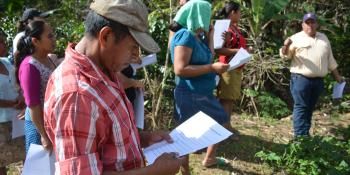TV show helps mobilize East African farmers to adopt climate-smart agriculture

Summary
The research was implemented in collaboration with the International Livestock Research Institute (ILRI).
Shamba Shape Up is an East African TV show that helps smallholders ‘make over’ their farms by providing help with recurrent agricultural challenges such as lack of water, pests and diseases, crop production and reaching markets. Using knowledge from CCAFS, CGIAR Centers, and numerous development partners, the show is increasingly presenting climate-smart agriculture (CSA) to East African smallholders—airtime dedicated to CSA is up to 35% of total programme time. The number of average viewers per month is over 9 million, 42% of which (over 5.5 million smallholders in 2014) have adopted new practices, boosting Kenya’s gross domestic product (GDP) by over USD 24 million in the maize and dairy sectors.
Shamba Shape Up’s SMS service has received messages from over 70,000 viewers since it began in 2012, with the second and third series generating over 37,000 texts in just 26 weeks. Internet use is also rising—the Facebook page has 20,000 followers and the Africa Knowledge Zone 400,000 hits. So the audience is accessing the programme off air and online, too.
CGIAR scientists and development partners proactively engage with Shamba Shape Up. Parent company Mediae is expanding CSA platforms in East Africa by linking to their iShamba mobile, SMS and Internet services. For example, Shamba Shape Up undertook a study for the World Bank to evaluate how to improve risk management in agriculture in Kenya.
Key facts
- Shamba Shape Up has over 9 million average monthly viewers.
- In 2014, 42% of Shama Shape Up viewers (over 5.5 million) adopted new practices, boosting Kenya’s GDP by USD 24 million from productivity increase in maize and dairy.
Lessons: key elements of success
- Dissemination of CSA information in a creative manner via television reaches a wide audience.
- Bringing together a range of interactive formats, such as television, SMS, iShamba etc., gives farmers the ability to access, interact and ask questions regarding agricultural production, markets and seasonal forecasts.
Further reading
- Shamba Shape Up homepage
- These are some of the impacts an agriculture TV-show can have
- Searching for that evergreen farm with the Shamba Shape Up make-over team
Related research outputs
- Shamba Shape Up. 2014. Assessing the impacts of Shamba Shape Up. AECF and University of Reading Report.
- The Mediae Company. 2013. Shamba Shape Up Series 2 and 3 KAPs Report.


